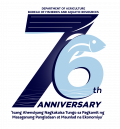The Department of Agriculture – Bureau of Fisheries and Aquatic Resources (DA-BFAR) released its first assessment report on illegal, unreported, and unregulated (IUU) fishing in Philippine waters today, September 14, in a roundtable discussion organized at BFAR Central Office in Quezon City.
The Philippine IUU Fishing Assessment Report 2021 presents estimates of the country’s overall IUU fishing risk exposure based on assessments, using the IUU Fishing Index and Threat Assessment (I-FIT) Tool, conducted from 2020 to 2021 by 777 fisheries experts and stakeholders from 160 cities and municipalities in nine of the 12 Philippine fishing management areas (FMAs).
The I-FIT Tool was developed by DA-BFAR and the United States Agency for International Development (USAID), through Fish Right and the Marine Environment and Resources Foundation and was launched in June 2021. The latest version of the tool is targeted at assessing the prevalence* of IUU fishing in waters under the local government units’ (LGUs) jurisdiction and the LGUs’ vulnerability* and response* to IUU fishing.
The scores derived from the I-FIT Tool are mostly within the 2.00 to 3.00 range of the I-FIT scale which indicates an overall moderate risk to IUU fishing. In particular, the national IUU fishing index, prevalence, vulnerability, and response scores are averaging 2.58, 2.51, 2.53, and 2.76, respectively.
The major findings of the assessment report include, first, IUU fishing is observed to be decreasing as 52 percent of the LGUs rated as having fairly strong enforcement teams. The most commonly reported IUU fishing responses in LGUs are sea patrols, establishment of Bantay Dagat, fisheries registration and issuance of municipal ordinances, and financial and livelihood assistance for fisheries.
Second, the use of I-FIT Tool has provided greater clarity, at a granular level, on what the top fishing threats are and where the hotspots could be. The report states that fishing with fine mesh net appears to be the most common IUU fishing with 74 percent of respondents reported cases of which in their areas.
Lastly, the registration and licensing of all fishing boats, both municipal and commercial, must be encouraged and incentivized since the largest contributor to IUU catch in terms of volume is fishing without registration, permits, or licenses. Moreover, illegal fishing appears to increase in number in areas where there is poor registration and licensing.
Meanwhile, the report recommends the following: (1) the I-FIT Tool shall be applied at FMA scales to include poaching in the Philippine exclusive economic zone; (2) BFAR shall assist LGUs nationwide to use the tool regularly and provide them with tools for reducing IUU fishing; and (3) the Bureau shall continue to provide national support in areas that are vulnerable to IUU fishing and areas with LGUs having difficulty in managing on their own waters.
The preparation of the report was facilitated by the Fish Right Program, a sustainable fisheries partnership between DA-BFAR and USAID that aims to reduce threats to marine biodiversity, improve fisheries management and governance, and increase fish biomass in some of the Philippines’ key marine areas.
“IUU fishing activities persist around the world because their extent is little known or understood. These activities are inherently clandestine and complex, making data collection difficult; thereby creating blind spots that inhibit our ability to address them effectively. USAID, DA-BFAR, and other key partners facilitate improved understanding of IUU fishing in the Philippines through assessments of its prevalence and the country’s vulnerability and response to its threat,” Ryan Washburn, USAID Mission Director for the Philippines, Pacific Islands and Mongolia, wrote in the report.
In its 75 years, DA-BFAR has been consistent in maintaining its unparalleled service to address IUU fishing in the country. This is achieved through various initiatives such as the Integrated Marine Environment Monitoring System and the continuous patrolling of its floating assets. Moreover, the Bureau has been developing new and innovative tools, such as the (I-FIT) Tool, to measure IUU fishing risks in municipal waters.
BFAR’s officer-in-charge Director Nestor D. Domenden said during a roundtable discussion, “One of the ways DA-BFAR promotes a more comprehensive strategy for eliminating IUU fishing in our seas is through the I-FIT Tool. The I-FIT Tool supports the science-based, participatory and sustainable management of fisheries resources by giving fisheries managers an understanding on the extent of IUU fishing.”
The Philippine IUU Fishing Assessment Report 2021 can be accessed and downloaded at DA-BFAR’s website. Meanwhile, efforts are underway to scale the tool for use at the FMA level.
#TagapagtaguyodNgMalinisAtMasaganangKaragatan
#FishConservationWeek
#MANAMo2022
















